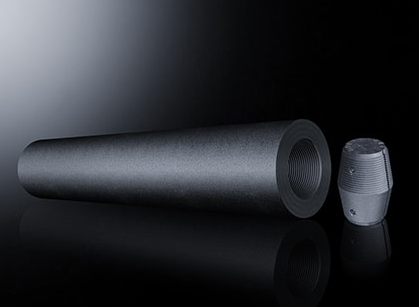

Graphite is an allotrope of carbon that exhibits unique properties, such as high thermal and electrical conductivity, high melting and boiling points, and lubricity. It is used in various industries, including metallurgy, electronics, and energy, due to its excellent thermal and electrical conductivity, chemical inertness, and high-temperature stability. In this article, we will discuss graphite rods, their properties, and applications.
Graphite Rods: Properties
Graphite rods are cylindrical-shaped structures made of graphite, which is a naturally occurring mineral or synthetic material produced by processing carbonaceous raw materials, such as petroleum coke, pitch coke, or coal tar pitch. The properties of graphite rods depend on their composition, manufacturing process, and structural arrangement. Here are some of the properties of graphite rods:
Electrical conductivity: Graphite rods are excellent conductors of electricity due to the presence of free electrons that can move easily within the graphite structure.
Thermal conductivity: Graphite rods have a high thermal conductivity, which makes them suitable for use in high-temperature applications, such as in nuclear reactors and aerospace industry.
Lubricity: Graphite rods have a low coefficient of friction, which makes them ideal for use as lubricants in high-temperature and high-pressure applications, such as in engines and drilling equipment.
Chemical stability: Graphite rods are chemically stable and do not react with most chemicals, making them suitable for use in corrosive environments.
High-temperature stability: Graphite rods have a high melting point (around 3652°C) and can withstand high temperatures without undergoing significant thermal expansion or deformation.
Graphite Rods: Manufacturing
Graphite rods can be manufactured by using different techniques, including extrusion, compression molding, isostatic pressing, and vibration molding. The choice of the manufacturing technique depends on the desired properties and the application requirements. Here are some of the manufacturing techniques used for graphite rods:
Extrusion: In this process, graphite powder is mixed with a binder, such as pitch or resin, to form a dough-like mixture. The mixture is then extruded through a die to form a rod shape. The extruded rods are then baked to remove the binder and sintered at high temperatures to form a dense and uniform structure.
Compression molding: In this process, graphite powder is compacted into a mold under high pressure and temperature to form a solid shape. The molded shape is then baked and sintered to form a dense and uniform structure.
Isostatic pressing: In this process, graphite powder is placed in a rubber or plastic bag and subjected to high pressure from all directions using an isostatic press. The pressure causes the graphite particles to pack tightly and form a solid shape. The pressed shape is then baked and sintered to form a dense and uniform structure.
Vibration molding: In this process, graphite powder is poured into a mold and subjected to high-frequency vibrations. The vibrations cause the graphite particles to pack tightly and form a solid shape. The molded shape is then baked and sintered to form a dense and uniform structure.
Graphite Rods: Applications
Graphite rods have a wide range of applications due to their unique properties. Here are some of the applications of graphite rods:
Electrodes: Graphite rods are commonly used as electrodes in electric arc furnaces and other high-temperature applications due to their excellent thermal and electrical conductivity.
Heating elements: Graphite rods are used as heating elements in furnaces and ovens due to their high-temperature stability and excellent thermal conductivity.
Crucibles: Graphite rods are used as crucibles for melting and casting metals due to their chemical inertness and high-temperature stability.
Lubricants: Graphite rods are used as solid lubricants in high-temperature and high-pressure applications, such as in engines and drilling equipment, due to their low coefficient of friction.
Nuclear reactors: Graphite rods are used as moderators and reflectors in nuclear reactors due to their high-temperature stability and excellent thermal conductivity.
Aerospace industry: Graphite rods are used in the aerospace industry for manufacturing structural components, such as wing spars and fuselage frames, due to their high strength-to-weight ratio and excellent thermal conductivity.
Energy storage: Graphite rods are used in energy storage devices, such as batteries and supercapacitors, due to their high electrical conductivity and high surface area.
Chemical processing: Graphite rods are used in the chemical processing industry for manufacturing corrosive-resistant equipment, such as heat exchangers and pumps, due to their chemical stability.
Semiconductor industry: Graphite rods are used in the semiconductor industry for manufacturing crucibles, boats, and heaters for processing silicon wafers due to their high purity and low contamination.
Medical industry: Graphite rods are used in the medical industry for manufacturing prosthetics, such as artificial joints, due to their biocompatibility and high strength.
Conclusion
Graphite rods are an important material with unique properties, such as high thermal and electrical conductivity, lubricity, chemical stability, and high-temperature stability. They are used in various industries, including metallurgy, electronics, energy, aerospace, and medical, for a wide range of applications, such as electrodes, heating elements, crucibles, lubricants, nuclear reactors, energy storage, chemical processing, semiconductor manufacturing, and medical prosthetics. The manufacturing process of graphite rods depends on the desired properties and the application requirements, and can be done using techniques such as extrusion, compression molding, isostatic pressing, and vibration molding. Graphite rods are expected to have an increasing demand in the future, especially in the energy storage and semiconductor industries, due to their unique properties and versatilit
